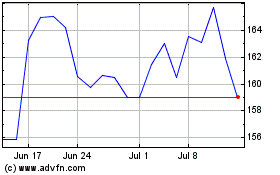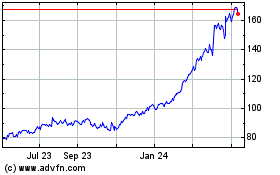GE Unit Expands Program to Speed U.S. Imports Through Supply Chains
March 06 2018 - 1:01PM
Dow Jones News
LONG BEACH, Calif.--Companies that ship and handle goods moving
through supply chains have a problem: they don't often know where
their shipments are in far-flung freight networks or when they will
arrive.
GE Transportation, a division of General Electric Co., said this
week it will work with California's Port of Long Beach, the
nation's second largest container port, to collect information on
inbound cargo and share it with transport and logistics operators
that now have only a murky view of when shipments will land at
docks and distribution centers.
At least two Long Beach terminals will participate in a two- to
three-month pilot of a program aimed at speeding up the flow of
goods from import gateways to warehouses, stores and factories by
giving companies a better idea of when and where to place the
trucks, railcars and other equipment that carry shipments through
distribution channels.
The program follows a similar test-run at the neighboring Port
of Los Angeles, the nation's top container port, which launched in
late 2016. Los Angeles expanded that pilot last summer and said it
expects an 8% to 12% improvement in overall supply chain efficiency
once the program rolls out across the entire port.
GE Transportation's Port Optimizer software brings together data
from shipping companies, port terminal operators, freight railroads
and other supply chain players into a single portal, and makes the
information available two weeks before a cargo ship arrives. GE
Transportation also said it's now working with software provider
project44 to make all the data available in real time.
"Until everyone is getting that information, you're going to run
into a friction point," said Jennifer Schopfer, vice president of
transport logistics at GE Transportation.
Without the software, many of the firms involved may not know
what's coming until as little as two days before it arrives; even
when shipping information is provided to the cargo owner, it
doesn't always reach the freight haulers that pull containers from
the port.
With all the information in one place, Ms. Schopfer said,
carriers and service providers will have time to line up the right
equipment and labor, make appointments for container pickup and
drop-off, plan where containers will be stowed on the docks and
make other arrangements. "Those people all have to work together to
move the cargo and they can't work together if they're not sharing
the information," she said.
"Tools like this will help us track our inventory more closely,"
said Deborah Ryan, vice president of global transportation and
logistics at Ascena Retail Group Inc., which owns Ann Taylor, Lane
Bryant and other women's apparel brands.
"The ability to know exactly where cargo is at any given time
will help us make better decisions about how to deploy inventory,"
Ms. Ryan said. "The ability to analyze historical performance will
enable us to choose the most reliable providers as well as pinpoint
where bottlenecks may occur and take proactive measures."
Last year, the ports of Los Angeles and Long Beach handled a
combined 16.9 million 20-foot equivalent units, a standard measure
for container cargo.
Write to Erica E. Phillips at erica.phillips@wsj.com
(END) Dow Jones Newswires
March 06, 2018 12:46 ET (17:46 GMT)
Copyright (c) 2018 Dow Jones & Company, Inc.
GE Aerospace (NYSE:GE)
Historical Stock Chart
From Mar 2024 to Apr 2024

GE Aerospace (NYSE:GE)
Historical Stock Chart
From Apr 2023 to Apr 2024
